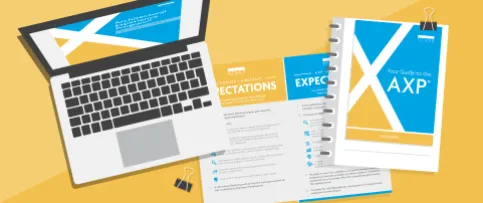The Architectural Experience Program® (AXP®) is a key step on the path to licensure designed to guide you through developing competency in architectural practice areas related to health, safety, and welfare. Through the AXP, you’ll gain and document the real-world experience needed to become an architect.
Understanding the Basics
The AXP program provides the framework that guides you through earning and recording your professional experience. The AXP prepares you to practice architecture independently—covering everything from site design to project management. Through the AXP, you’ll:
- Learn and experience the daily realities of architectural practice
- Acquire comprehensive experience in basic practice areas
- Explore specialized areas of practice
- Develop professional judgment
- Refine your career goals
You can start your AXP journey and begin reporting experience gained after you have graduated from high school (or the equivalent). You must demonstrate that you can competently perform the tasks identified across the six experience areas to complete the program.
Note: Each U.S. jurisdiction sets its own requirements for initial licensure, and some require additional experience. Check the licensing requirements tool to explore your jurisdiction’s requirements.
Program Overview
The AXP identifies 96 key tasks you should be able to competently perform at the point of licensure. The tasks are spread across six practice-based areas:
- Practice Management
- Project Management
- Programming & Analysis
- Project Planning & Design
- Project Development & Documentation
- Construction & Evaluation
Each experience area aligns with an ARE 5.0 division, allowing you to connect your real-world experience to your exam preparation.
The 96 tasks are designed to span the phases of an early career in architecture. Some tasks are simpler and can be completed earlier in your career, while others may require skills and experience that are developed over time. On average, candidates spend 4-5 years completing the AXP, so don’t be discouraged if you can’t tackle every task right away!
Most candidates who complete the AXP will document their experience by submitting hourly experience reports, which will be reviewed and approved by your supervisor. To complete the AXP, you must report a total of 3,740 hours of experience across the six areas. You can find the individual tasks for each experience area in the AXP Guidelines—use the tasks to ensure you gain the appropriate experiences to build your competence.
Establishing a Record and Recording AXP Experience
To report your experience, you’ll need to establish an NCARB Record—a detailed online account of your professional history that you’ll use to complete the AXP, take the ARE, and earn your license to practice.
To earn full credit toward the AXP for your work, you’ll need to document your hours within the program’s reporting requirement: submit experience within eight months of earning it for 100% credit, or within five years for 50% credit.
Experience Settings
Your work will be reported under one of two experience settings. These settings define the type of organization, the work performed, and who verifies your experience. Nearly half of your documented experience (1,860 hours) must be gained while employed by an architecture firm legally practicing architecture and under the supervision of a licensed architect in the United States or Canada—which is considered experience setting A.
- Experience Setting A: Work performed in an architecture firm (1,860 hours required)
- Experience Setting O: Experience opportunities outside an architecture firm (Each opportunity under setting O has a maximum limit. There is no requirement to do this experience opportunity.)
We recently dove into experience setting O and the many opportunities offered through this experience setting. Learn more about setting O and find full details about both experience settings in the AXP Guidelines.
Supervisors and Mentors
All experience reports must be reviewed and approved by an AXP supervisor (or, in some settings, a qualified mentor). You’ll work closely with your supervisor to develop a plan to build up your knowledge and skills and meet your licensure goals. Learn more about your supervisor’s role on your path to licensure.
AXP Portfolio
While most candidates complete the AXP by submitting hourly experience reports, some will complete an AXP Portfolio instead. If you have significant work history in architecture that’s older than five years, you might be eligible for this path. Through this option, you’ll demonstrate your competency in the AXP’s 96 tasks by uploading exhibits—documents, PDFs, images, or other files—of work for approval by your supervisor. Learn more about the AXP Portfolio to see if you qualify.
For more detailed information about the AXP and what’s required to become a licensed architect, check out the AXP Guidelines and our blog for the latest updates.



